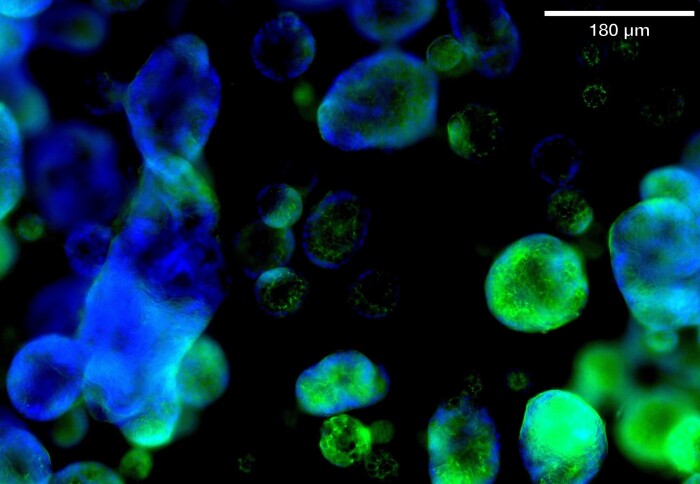New Organoid Facility for cutting-edge disease modelling and precision medicine

3D human colon organoids where the nuclei and the tight junctions have been labelled (blue and green, respectively).
A new Imperial Facility will be a central research and technology hub to develop human stem cell-based disease models, called organoids.
As part of the recent NIHR award to the Imperial Biomedical Research Centre (BRC), the NIHR Imperial BRC Organoid Facility will serve as a multi-disciplinary research, technology development and training hub to decrease the barrier to accessing stem cell and organoid-related methods.
“The new NIHR Imperial BRC Organoid Facility will move the world-class stem-cell based research happening in the College to another level." Dr Tamas Korcsmaros Organoid Facility co-lead
The Facility will support organoid work (both iPSC or adult biopsy-derived organoid culture) by operating a main laboratory for general culture and future biobanking, as well as developing complex disease models for multi-omics readouts.
Hosted by the Department of Metabolism, Digestion and Reproduction on the 10th Floor of the Commonwealth Building, Hammersmith Hospital Campus, the Facility co-locates world-class researchers, technology developers from Imperial's Faculty of Engineering, businesses, and higher education partners in the innovation hub of West London.
Its location and vicinity to the Hammersmith Hospital also allow researchers to develop organoid lines together with the Imperial College Healthcare NHS Trust to include relevant clinical metadata, as well as giving access to experiment readouts with the omics platforms already available at Hammersmith Campus, i.e. the MRC-NIHR BRC National Phenome Centre and the NIHR Imperial BRC Genomics Facility.
State-of-the-art equipment

The main lab provides a large space to securely work in parallel with various models. The lab contains state-of-the-art equipment to support organoid culturing and training of it. These instruments include the ECHO Revolve microscope, which is four microscopes in one (with brightfield colour; monochrome fluorescence; upright position and inverted position options).
Alongside this, the NEPA21 Super Electroporator will allow researchers genetically modify organoids. Genetically engineering human organoids will allow precise disease modelling (e.g. introducing or fixing disease-associated mutations and changes in the genome) and the development of specific fluorescence reporter organoids that can be used in the future for screening and precision medicine purposes.
Dr Tamas Korcsmaros, co-lead of the Facility, said: “The new NIHR Imperial BRC Organoid Facility will move the world-class stem-cell based research happening in the College to another level. Human patient-derived organoids are revolutionising biomedical and clinical research, and this Facility will enable Imperial to translate its major biological and medical research into clinical practice.
“By working together with colleagues from the Faculty of Engineering and Imperial’s Organ-on-Chip Network of Excellence, we have the goal to further develop complex organ models using organoids and microfluidics-based organ-on-chip systems. This will allow researchers to study cell-cell and cell-microbiome interactions much closer to the physiological (in vivo) situation than using current cell culture and animal models.
Using organoids as tools in precision medicine

Professor Mark Thursz, Director of the NIHR Imperial BRC and Head of the Department of Metabolism, Digestion and Reproduction, said: “It was exciting when we wrote the concept of having an Organoid Facility into our successful BRC application and now I am incredibly proud to see it completed. Researchers can, of course, learn things through mice and animal models, but here we are focused on understanding human disease and developing interventions that our patients need, so organoids based around human cells from patients are absolutely critical."
Dr Korcsmaros continued: "At Imperial, we are now able to develop more adequate disease models and study them with established and cutting-edge multi-omics approaches. The Facility will significantly contribute to the development and validation of using organoids as tools in precision medicine, i.e. to find the right therapy for the right patient.
"The Organoid Facility will coordinate and support the organoid-based work throughout the BRC and the College, interacting with various BRC Themes, other BRC Facilities and various Departments and Faculties to deliver multi-disciplinary and translational projects.”
The Organoid Facility aims to provide space and expertise for pilot projects, as well as additional support in grant applications. To leverage the vast expertise Imperial College has in stem cell-based models, clinical research and bioengineering, the Organoid Facility will establish cross-faculty, cross-departmental and cross-disciplinary communication channels. This will be achieved by organising a seminar series from October 2023, focused workshops and informal monthly ‘Organoid Coffees’ to help each other and create a community. Students, staff or clinicians who are interested in these activities can sign up for the Facility email list.
“This is a very exciting time, and we all look forward to seeing how the Organoid Facility will catalyse cutting-edge disease modelling and precision medicine research.” said Dr Korcsmaros.
To express your interest in accessing the Facility, please contact the team to arrange a tour and introduction.
This Facility was funded by the NIHR Imperial Biomedical Research Centre (BRC).
Article supporters
Article text (excluding photos or graphics) © Imperial College London.
Photos and graphics subject to third party copyright used with permission or © Imperial College London.
Reporter
Benjie Coleman
Department of Surgery & Cancer